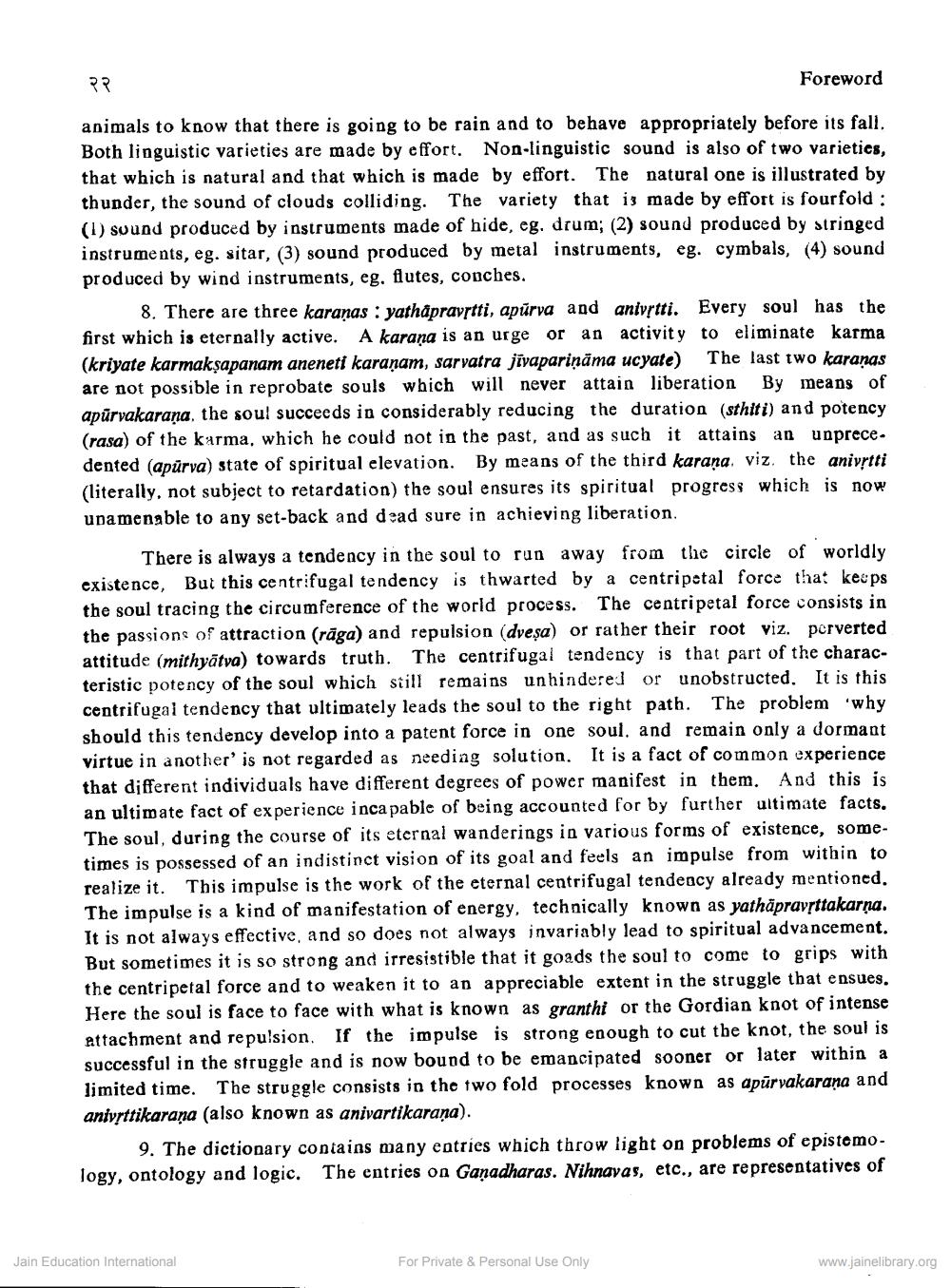________________
२२
Foreword
animals to know that there is going to be rain and to behave appropriately before its fall. Both linguistic varieties are made by effort. Non-linguistic sound is also of two varieties, that which is natural and that which is made by effort. The natural one is illustrated by thunder, the sound of clouds colliding. The variety that is made by effort is fourfold: (1) sound produced by instruments made of hide, eg. drum; (2) sound produced by stringed instruments, eg. sitar, (3) sound produced by metal instruments, eg. cymbals, (4) sound produced by wind instruments, eg, flutes, couches.
8. There are three karanas: yathapravṛtti, apurva and antvrtti. Every soul has the first which is eternally active. A karana is an urge or an activity to eliminate karma The last two karanas (kriyate karmakṣapanam aneneti karaṇam, sarvatra jivapariņāma ucyate) are not possible in reprobate souls which will never attain liberation By means of apūrvakaraṇa, the soul succeeds in considerably reducing the duration (sthiti) and potency (rasa) of the karma, which he could not in the past, and as such it attains an unprece dented (aparva) state of spiritual elevation. By means of the third karana. viz. the anivṛtti (literally, not subject to retardation) the soul ensures its spiritual progress which is now. unamenable to any set-back and dead sure in achieving liberation.
There is always a tendency in the soul to run away from the circle of worldly existence, But this centrifugal tendency is thwarted by a centripetal force that keeps the soul tracing the circumference of the world process. The centripetal force consists in the passions of attraction (räga) and repulsion (dveja) or rather their root viz. perverted attitude (mithyatva) towards truth. The centrifugal tendency is that part of the charac teristic potency of the soul which still remains unhindered or unobstructed. It is this centrifugal tendency that ultimately leads the soul to the right path. The problem why. should this tendency develop into a patent force in one soul, and remain only a dormant virtue in another' is not regarded as neediag solution. It is a fact of common experience that different individuals have different degrees of power manifest in them. And this is an ultimate fact of experience incapable of being accounted for by further ultimate facts. The soul, during the course of its eternal wanderings in various forms of existence, sometimes is possessed of an indistinct vision of its goal and feels an impulse from within to realize it. This impulse is the work of the eternal centrifugal tendency already mentioned. The impulse is a kind of manifestation of energy, technically known as yathāpravṛttakarṇa. It is not always effective, and so does not always invariably lead to spiritual advancement. But sometimes it is so strong and irresistible that it goads the soul to come to grips with the centripetal force and to weaken it to an appreciable extent in the struggle that ensues. Here the soul is face to face with what is known as granthi or the Gordian knot of intense attachment and repulsion. If the impulse is strong enough to cut the knot, the soul is successful in the struggle and is now bound to be emancipated sooner or later within a The struggle consists in the two fold processes known as apurvakarana and anivrttikarana (also known as anivartikarana).
9. The dictionary contains many entries which throw light on problems of epistemology, ontology and logic. The entries on Ganadharas. Nihnavas, etc., are representatives of
Jain Education International
For Private & Personal Use Only
www.jainelibrary.org




